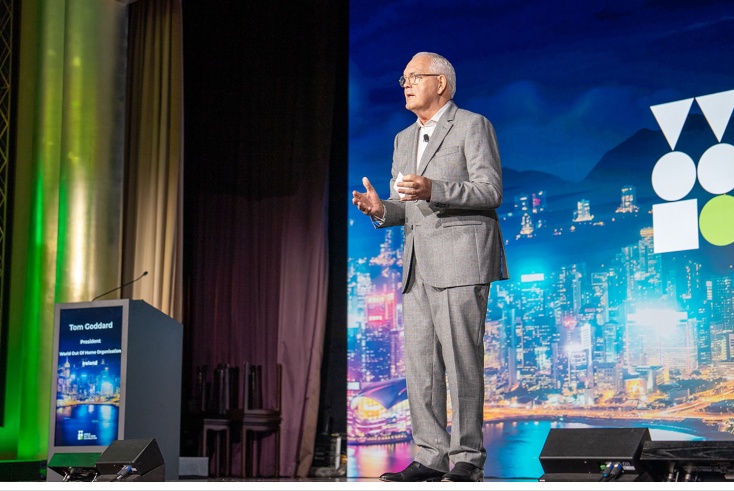Opinion
Route CEO Denise Turner shares her key learnings from the World Out of Home Organization event in Hong Kong.
Last week, I had the privilege of attending the World Out of Home Organization (WOO) Global Congress in Hong Kong. It was the first of its kind in Asia.
The congress was opened by the Hong Kong under-secretary of commerce, Dr Bernard Chan Pak-Li. He talked about how this city is a melting pot of cultures, a blend of East and West.
It’s a microcosm of the event itself — more than 500 delegates from 47 countries! So many different viewpoints, but a huge sense of a common purpose.
I’m still processing what I heard, discussed and observed, but here are my takeaways — in no particular order.
Collaboration
I’m blown away by the amount of collaboration around the world, within markets and within disciplines.
After 30 years in the industry, moving into OOH has given me a fresh enthusiasm for how we can work together to make things better.
And, indeed, it was one of WOO president Tom Goddard’s key ingredients for success and growth in the medium term.
Optimism
OOH is optimistic about the future.
Expenditure data shows that global spending on OOH advertising reached $41.9bn in 2023, up 16% on 2022’s $36.2bn, breaking through the 5% share-of-total-adspend barrier even as online continues to dominate media growth tables.
OOH now accounts for 5.2% of global ad expenditure, up from 2022’s 4.7%, and the growth trend is set to continue.
Inspiration
I was reminded that the success of a medium is only as good as the creative it conveys.
As Sylvain Borgne from JCDecaux said so eloquently, marketing works best when great creative is shown in great media. And that is vitally important for outdoor advertising.
In all other channels, the advertising surrounds and plays off content. Not the case here.
There were lots of examples of creative that drove brand perceptions and that used technology to power dynamic in-the-moment solutions.
OOH does both so well — and it makes a difference.
One of my highlights was the guarded bus stop from Eletromidia in São Paulo. With the goal of making everyone, and women in particular, feel safer while waiting alone at bus stops at night, the shelters’ digital advertising displays are adapted to make video calls after dark.
Connected to the internet, with microphones and night-vision cameras, the equipment goes live between 8pm and 5am, and connects whoever’s waiting at the stop with Eletromidia’s call centre, which provides someone to keep them company until their bus arrives.
In New Zealand, there was a great example of using programmatic digital OOH to give people information in real time — in this case, letting them know about air pollution and any imminent fire risk so they could be prepared.
It was also great to hear about the practical actions being taken in the sustainability space from around the world, including our very own Clear Channel from the UK. It’s now about walking the talk.
There are so many more examples of great OOH. My advice to anyone working in planning and buying is to let yourself be inspired.
Ease
On the eve of the conference, Goddard talked about the areas holding OOH back and one of those was adtech.
To be clear, it’s not that we need more; it’s that we need to co-ordinate it.
One presentation on this topic that stood out was led by Annie Rickard from OOH Capital.
She was accompanied by Ben Milne (global OOH lead at Dentsu), Emma Hegg (group director for platform strategy at oOh! in Australia) and Gavin Lee (senior product director at Broadsign), and with a very funny video depicting the planning and buying process, they challenged the audience to differentiate between programmatic and automation.
The industry needs to make all OOH easy and seamless to buy.
As an aside, we of course also discussed AI. It is a useful tool, but as Ocean Outdoor’s Stephen Joseph said: “Use AI; don’t let AI use you!”
It’s a timely reminder that we need to make it work for us, not the other way round.
Audiences
And, finally, a topic that was also highlighted in advance of the congress: the importance of audience measurement.
Robust, stable, reliable and representative data is required to underpin growth. And that is going to be different in different markets.
I took part in a panel with the rather grand title of “Measure the World: The Pace Quickens”. To be fair, we did have a representative from the most populated market in the world in India (population: 1.4bn); as well as Great Britain (population: 65m), we also had Australia (population: 26m) and Sweden (population: 10m).
There were three observations here. First, we market to people, not devices — people buy products, so we need to count them.
Secondly, more than many other channels, OOH relies on integrating multiple datasets, so they need to be tested and be fit for purpose.
Thirdly, while we need to always keep in mind our end goal, we need to start somewhere.
My Route colleague Euan Mackay recently introduced me to a quote from Ferdinand Magellan, the legendary Portuguese explorer: “The sea is dangerous and its storms terrible, but these obstacles have never been sufficient reason to remain ashore.”
 Denise Turner is CEO of Route
Denise Turner is CEO of Route
Adwanted UK is the trusted delivery partner for three essential services which deliver accountability, standardisation, and audience data for the out-of-home industry.
Playout is Outsmart’s new system to centralise and standardise playout reporting data across all outdoor media owners in the UK.
SPACE is the industry’s comprehensive inventory database delivered through a collaboration between IPAO and Outsmart.
The RouteAPI is a SaaS solution which delivers the ooh industry’s audience data quickly and simply into clients’ systems.
Contact us for more information on SPACE, J-ET, Audiotrack or our data engines.






 Denise Turner is CEO of Route
Denise Turner is CEO of Route